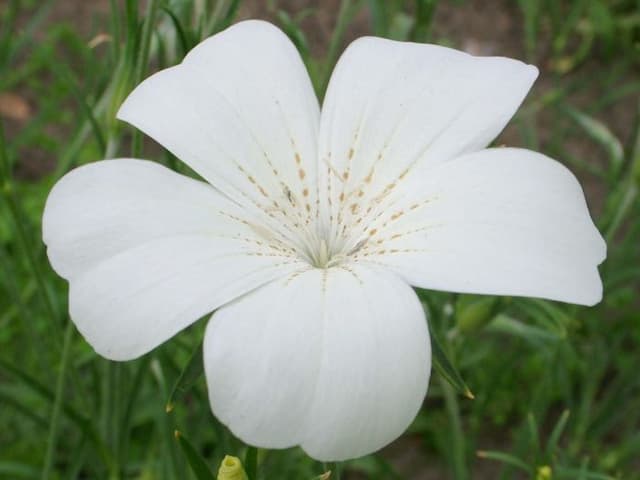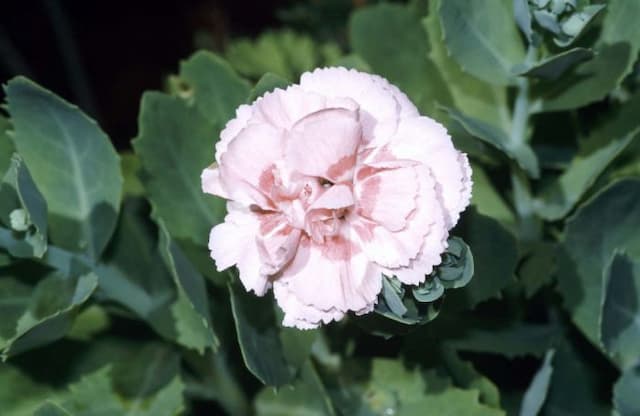Carnation Dianthus 'David Saunders' (b)

ABOUT
Dianthus 'David Saunders' (b), commonly known as Pinks or Sweet William, is a striking ornamental plant known for its colorful and fragrant flowers. The plant has a dense, tuft-like growth with narrow, linear leaves that are typically grayish-green to blue-green in color. Its foliage forms a lush mound which serves as a beautiful backdrop for its standout feature, the blooms. The flowers of this Dianthus are particularly eye-catching, often appearing in vibrant hues. Each bloom is comprised of a series of petals arranged in a tight, frilly fashion, giving the flower a ruffled look that is both elegant and whimsical. The petals can display a range of patterns, sometimes exhibiting a two-toned effect or distinct markings that enhance their overall appeal. What makes these plants most compelling is their sweet, clove-like fragrance that can perfume an entire garden area, especially on warm, calm days. The scent is as much a part of the Dianthus experience as the visual splendor of its blossoms. These aromatic flowers attract various pollinators, adding to the environmental benefits of planting them. While the size of this plant has been omitted from the description, it is important to note that Pinks have a compact growing habit, making them suitable for a variety of garden settings, borders, and pots where their colorful displays and delightful fragrance can be fully appreciated.
About this plant
 Names
NamesFamily
Caryophyllaceae
Synonyms
Pinks, Carnations, Sweet William
Common names
Dianthus 'David Saunders'
 Toxicity
ToxicityTo humans
Carnations, including the Dianthus 'David Saunders', are generally not considered toxic to humans. Ingestion of parts of this plant is not likely to cause serious harm. However, some people might be sensitive to carnations and could experience mild gastrointestinal upset if large amounts are ingested. It's always best to avoid eating ornamental plants as a precaution.
To pets
Carnations are not highly toxic to pets. However, if a pet ingests a considerable amount of the plant, it might experience mild gastrointestinal distress, such as vomiting or diarrhea. These symptoms are typically not severe and should resolve on their own. If a pet consumes a significant quantity of carnations and shows signs of illness, it is advisable to consult a veterinarian.
 Characteristics
CharacteristicsLife cycle
Perennials
Foliage type
Evergreen
Color of leaves
Green
Flower color
Pink
Height
1 foot (30 cm)
Spread
1 foot (30 cm)
Plant type
Herb
Hardiness zones
Varies
Native area
Europe
Benefits
 General Benefits
General Benefits- Attractive Blooms: Dianthus 'David Saunders' produces bright and colorful flowers that can enhance the visual appeal of any garden or landscape.
- Drought Tolerance: Once established, they are quite drought-tolerant, making them suitable for xeriscaping and low-water gardens.
- Cold Hardy: This plant is capable of surviving in colder climates, making it a good choice for gardens in temperate zones.
- Long Blooming Period: It can bloom from late spring through early fall, providing a long season of color.
- Fragrance: The flowers of Dianthus are known for their sweet and spicy fragrance, which can be a delightful addition to gardens and patios.
- Attracts Pollinators: The blooms attract butterflies and other beneficial pollinators, supporting local ecosystems.
- Low Maintenance: Dianthus 'David Saunders' requires minimal care once established, making it a convenient option for busy gardeners.
- Edging and Borders: Their growth habit makes them ideal for use as edging plants or in borders, adding structure to garden designs.
- Container Gardening: They can be grown in containers, providing flexibility for those with limited space or who wish to decorate patios and balconies.
 Medical Properties
Medical PropertiesThis plant is not used for medical purposes.
 Air-purifying Qualities
Air-purifying QualitiesThis plant is not specifically known for air purifying qualities.
 Other Uses
Other Uses- Dianthus 'David Saunders' can be used for floral art and competitive flower arranging due to their vivid color and long-lasting blooms.
- The petals of Dianthus, commonly known as pinks or carnations, are edible and can be used as a colorful garnish in salads or as decorations on cakes.
- The flowers can be infused to make a lightly fragranced Dianthus tea, which is enjoyed for its unique flavor.
- Dried Dianthus petals are used in potpourri to add fragrance and color to a room.
- Dianthus flowers can be pressed and included in homemade paper for an artistic and personalized touch.
- Petals of the Dianthus can be used in natural dyeing processes to impart a range of pink and neutral tones to textiles.
- The plant can be used in companion planting to attract pollinators such as bees and butterflies to the garden, benefiting other plants nearby.
- When planted in a vegetable garden, Dianthus 'David Saunders' can serve as a border that provides a splash of color amidst the greenery.
- These flowers can be used in perfumery to capture their essence as a component in creating fragrances.
- Some cultures use Dianthus flowers in traditional ceremonies and celebrations as a symbol of love and admiration.
Interesting Facts
 Feng Shui
Feng ShuiThe Carnation is not used in Feng Shui practice.
 Zodiac Sign Compitability
Zodiac Sign CompitabilityThe Carnation is not used in astrology practice.
 Plant Symbolism
Plant Symbolism- Love and Affection: Dianthus flowers, including the 'David Saunders' variety, are often associated with love and affection, symbolizing a deep emotional attachment, possibly due to their lingering and sweet fragrance.
- Admiration: The vibrant colors and resilient nature of dianthus are indicative of admiration, making them suitable for gifting when you want to show your esteem for someone.
- Passion: The rich colors of the 'David Saunders' dianthus can represent passion and strong feelings, often used to convey a message of intense love.
- Pure Love: Dianthus are also associated with pure or innocent love, hence their inclusion in wedding bouquets or ceremonial decorations to symbolize a commitment to love.
- Chivalry: With their historical ties to ancient nobility, dianthus plants may symbolize chivalry and honor, reflecting the virtues of an individual.
 Water
WaterSweet William requires consistent moisture, so water regularly, ensuring the soil is kept evenly moist. It's important not to overwater, as this can lead to root rot. Generally, watering once a week with about one to two inches of water should suffice, but this may vary depending on climate conditions and soil type. During particularly hot or dry spells, you may need to water twice a week. Use a soaker hose or drip irrigation to deliver water directly to the base of the plant, minimizing moisture on the foliage and flowers.
 Light
LightSweet William thrives in full sunlight, so plant it in a location where it can receive at least six to eight hours of direct sunlight daily. If you live in a particularly hot climate, Sweet William can benefit from some afternoon shade to prevent scorching, but generally, the more light it receives, the more it will flower.
 Temperature
TemperatureSweet William prefers cooler temperatures and will grow best when daytime temperatures are between 60 and 70 degrees Fahrenheit. It can survive minimum temperatures down to about 40 degrees Fahrenheit and can handle short periods of frost. Avoid planting in areas where the temperature exceeds 80 degrees Fahrenheit for extended periods as excessive heat can stress the plant.
 Pruning
PruningPrune Sweet William after the first flush of blooms to encourage a second blooming period. Remove dead flowers and any damaged or diseased foliage to maintain the plant's appearance and health. Pruning is typically done mid-season, once the initial flowers have faded, which usually occurs in late spring or early summer.
 Cleaning
CleaningAs needed
 Soil
SoilThe best soil mix for a pinks (Carnation) plant is well-draining and loamy. A mixture of one-third potting soil, one-third sand or perlite, and one-third compost or peat moss creates an ideal environment. The preferred soil pH for pinks is slightly alkaline, around 7.0 to 7.5.
 Repotting
RepottingPinks (Carnation) plants should be repotted every 2-3 years to refresh the soil and accommodate root growth. They are not rapid growers, so frequent repotting is not necessary unless the plant has outgrown its container.
 Humidity & Misting
Humidity & MistingPinks (Carnation) prefer moderate humidity levels but are quite adaptable and can tolerate dry air. The best humidity range for this plant is approximately 40-60%.
 Suitable locations
Suitable locationsIndoor
Provide bright light, well-draining soil, and good air circulation.
Outdoor
Plant in full sun, well-draining soil, and space for air flow.
Hardiness zone
3-9 USDA
 Life cycle
Life cycleThe life of the Dianthus 'David Saunders', commonly known as Pinks, begins with seed germination, typically in late winter or early spring, requiring well-draining soil and some warmth to sprout. Seedlings develop true leaves and grow into young plants, which can be transplanted outdoors after the last frost when they are sturdy enough. As the plants mature, they form a dense clump of grassy, blue-green foliage, and flower stalks emerge, blooming into fragrant pink, red, or white flowers in late spring to early summer, which attract pollinators such as bees and butterflies. After flowering, if the blooms are deadheaded, the plant may produce a second flush of flowers in late summer or early fall. In the autumn, the plant prepares for dormancy, with foliage dying back in response to cooler temperatures and shorter daylight hours. Over winter, the plant remains dormant as a perennial, preserving energy in its root system to regrow the following spring.
 Propogation
PropogationPropogation time
Spring-Early Summer
The Dianthus 'David Saunders', commonly known as Pink 'David Saunders', is typically propagated through cuttings, which is the most popular method for this plant. The best time to take cuttings is from late spring to early summer when the plant is actively growing and the stems are firm. To propagate, a gardener should select healthy non-flowering stems and cut a 4 to 6-inch (10 to 15 cm) piece, making sure to include several leaf nodes. The cut end of the stem is then dipped in rooting hormone powder to encourage root growth and planted in a mix of peat and perlite or sand to provide good drainage. The cutting should be kept moist and in a warm environment with indirect sunlight until roots have developed, which typically takes 2 to 4 weeks. Once rooted, the cutting can be transplanted into the garden or a pot with regular potting soil.








![Pink [Bubblegum]](/_next/image?url=https%3A%2F%2Fplants-admin.emdemapps.com%2Fimages%2Fplants%2F%2Fimages%2F604b596f31cbb.png&w=640&q=75)
